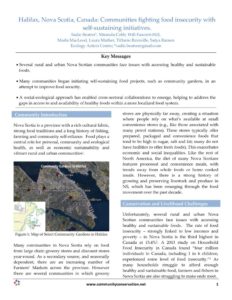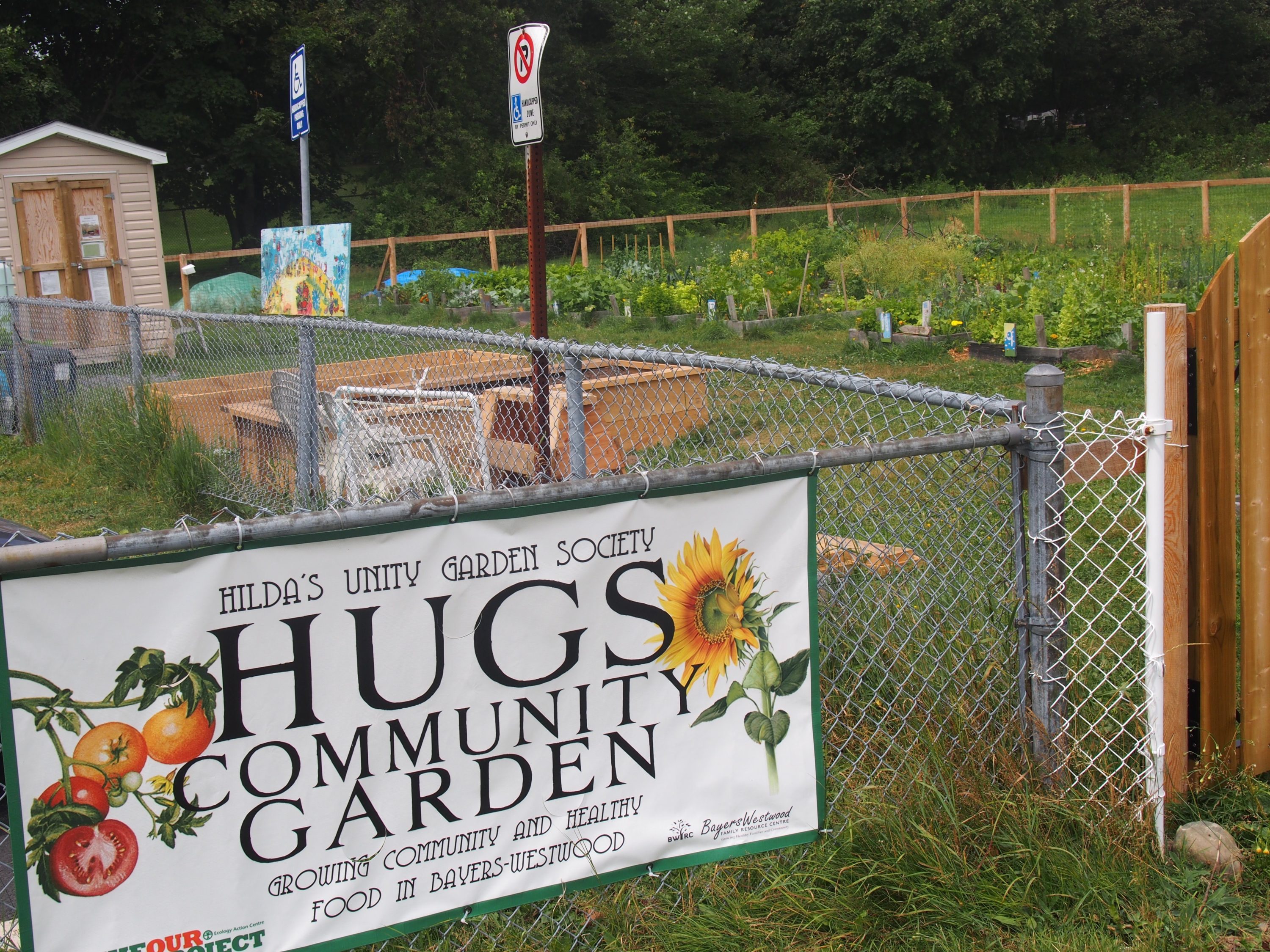
19 Dec Halifax, Nova Scotia, Canada
Sadie Beaton*, Miranda Cobb, Will Fawcett-Hill, Marla MacLeod, Laura Mather, Tiffanie Rainville, Satya Ramen
Ecology Action Centre; *sadie.beaton@gmail.com
Key Messages
• Several rural and urban Nova Scotian communities face issues with accessing healthy and sustainable foods.
• Many communities began initiating self-sustaining food projects, such as community gardens, in an attempt to improve food security.
• A social-ecological approach has enabled cross-sectoral collaborations to emerge, helping to address the gaps in access to and availability of healthy foods within a more localized food system.
Community Introduction
Nova Scotia is a province with a rich cultural fabric, strong food traditions and a long history of fishing, farming and community self-reliance. Food plays a central role for personal, community and ecological health, as well as economic sustainability and vibrant rural and urban communities1.
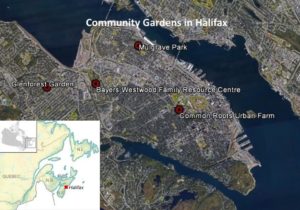
Figure 1: Map of Select Community Gardens in Halifax
Many communities in Nova Scotia rely on food from large chain grocery stores and discount stores year-round. As a secondary source, and seasonally dependent, there are an increasing number of Farmers’ Markets across the province. However there are several communities in which grocery stores are physically far away, creating a situation where people rely on what’s available at small convenience stores (e.g., like those associated with many petrol stations). These stores typically offer prepared, packaged and convenience foods that tend to be high in sugar, salt and fat; many do not have facilities to offer fresh foods). This exacerbates economic and social inequalities. Like the rest of North America, the diet of many Nova Scotians features processed and convenience meals, with trends away from whole foods or home cooked meals. However, there is a strong history of growing and preserving livestock and produce in NS, which has been resurging through the food movement over the past decade.
Conservation and Livelihood Challenges
Unfortunately, several rural and urban Nova Scotian communities face issues with accessing healthy and sustainable foods. The rate of food insecurity – strongly linked to low incomes and poverty – in Nova Scotia is the third highest in Canada at 15.4%2. A 2013 study on Household Food Insecurity in Canada found “four million individuals in Canada, including 1 in 6 children, experienced some level of food insecurity.”2 As many households struggle to afford enough healthy and sustainable food, farmers and fishers in Nova Scotia are also struggling to make ends meet.
Further undermining the strength of the local food system, Nova Scotian farmers and fishers are growing older, with an average age of 56 years and farm debt in Nova Scotia rose fourfold between 1983 and 20103,4. The next generation of farmers is struggling to access funds and supports to ensure our future food supply.
Food security is also connected to the knowledge and skills needed to prepare fresh foods. With prepared food (often unhealthy “fast food”) readily available and heavily marketed, along with multiple demands on our time, preparation of fresh foods is compromised. All of this has implications for the healthcare system, with the rates of some chronic disease in Nova Scotia being among the highest in the country5.
As a community response to these issues, people began initiating self-sustaining food projects, such as community gardens (Figure 1). In the past, community garden projects conducted by organizations have not always had success. The dynamic of underfunded organizations working with other underfunded organizations meant there was a propensity for projects to fail or be discontinued. Over time, it became apparent that enthusiasm was not enough to sustain individual garden projects, particularly in vulnerable communities.
Community Initiative
Since the early 2000s, community-based organizations have been taking a closer look at local food systems and working to improve access to healthy, sustainable food. This describes the work of four community groups in Halifax towards developing positive food environments: the Bayers Westwood Family Resource Centre (BWFRC), the Immigrant Settlement Association of Nova Scotia (ISANS), Mulgrave Park gardens and Common Roots’ Urban Farm (CRUF). These groups have all worked with and most continue to maintain a close relationship with the Ecology Action Centre (EAC), an environmental non-governmental organization that has been one of the first organizations in Atlantic Canada to begin connecting food systems and environmental issues. The EAC’s efforts on food issues have been supported since 2011 through funding from the Public Health Agency of Canada.
Bayers-Westwood:
The Bayers-Westwood community, of Halifax’s West End, is very diverse, consisting of 358 families, including 60% newcomers. These are mostly single parent families, with many living on disability and income assistance. As one community member described, “The food environment is very challenging. There is never enough food, the food bank runs out, and there are hardly any fruit and vegetables available.”
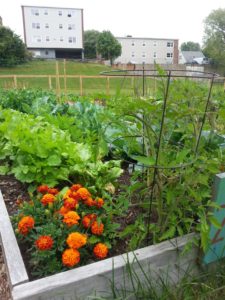
Figure 2: Community Garden at Bayers-Westwood
The community garden infrastructure and leadership has grown significantly since their partnership with the EAC. Bayers Westwood Family Resource Centre hired a seasonal garden coordinator, implemented a percentage of staff time toward food and garden programs, and established core volunteer roles for the ongoing maintenance and coordination of the garden. As a result, they now have capacity to grow more produce for initiatives like local pop-up markets, making their own garden preserves, and increase garden membership.
Although this community had initial success in gaining community garden plots, a lack of leadership prevented activity in the gardens. Engagement with the EAC has renewed leadership and enthusiasm (Figure 2 & 3). According to the Bayers Westwood Family Resource Centre, factors supporting healthy food access include growing space, knowledge and skill, and social support.
Glen Forest & Multicultural Community Gardens:
ISANS is a community organization that welcomes immigrants to Nova Scotia, offering services and creating opportunities for immigrants to participate in Canadian life. In 2012, ISANS started their first two community gardens; the Glen Forest Garden, followed by the Multicultural Community Garden in 2013. Although vandalism put the gardens at risk, engagement with the EAC has increased the capacity to effectively run the gardens.
Community members emphasized the need for social support, indicating a connection between social coordination and food access, for example through the ability to organize seed swaps, bulk food orders, and intergenerational language exchanges. Garden participants often lack basic social supports that affect their well-being, including mental health and livelihood outcomes. As one participant put it, “In my ideal world… I don’t have to make a decision between chicken and detergent.” As another describes, “I feel better about myself when I am able to buy necessities.”
Mulgrave Park:
Mulgrave Park is a vibrant public housing neighborhood with a rich history, comprised of primarily African-Nova Scotians, in the North End of Halifax, home to over 250 families. Progress in the Park (https://www.facebook.com/NSCIPA/) is a community development initiative that seeks to empower the residents of Mulgrave Park through entrepreneurial action that inspires inclusiveness and challenges stigma. One major focus of the initiative is food security, including community gardens. The community, with support from the EAC, has developed 12 accessible raised beds, which were built to address the needs of residents living beside the garden.
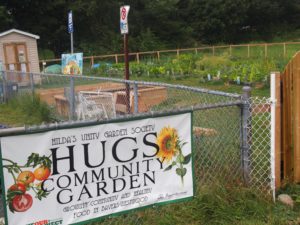
Figure 3: The HUGS Community Garden in Bayers-Westwood.
Due to the multiple intersecting social and economic barriers experienced by the majority of residents of Mulgrave Park, community members were hesitant to invest in the gardening project. However, the children’s program ‘Plants-to-Plates’ was incredibly successful at engaging youth, and many days during the summer you could find kids playing and working in the garden. 70% of youth involved reported eating more vegetables because of the garden program and parents became more open to the project through this. One parent had this to say about their children: “they love to help me at the garden, they enjoy watering, and enjoy the veggies that I have ready. :)” and “I have the veggies at the garden so I don’t need to buy. Just pick-up and enjoy and most important, no chemicals!”
Common Roots:
Common Roots Urban Farm (CRUF) is a garden located in front of the Queen Elizabeth II Hospital (Infirmary Site) in downtown Halifax. This project aims “to inspire a community-built vision of urban agriculture and productive landscapes” and along with over 100 individual and community plots, is made up of a market garden, edible landscaping, and places to sit and relax or learn and work together.
Unlike the other gardens, Common Roots has a large volunteer capacity and the majority of participants enjoy a mid-range income. Common Roots also engages with newcomers and immigrants, many of who are living on assistance. Through programs like Deep Roots, they invite newcomers to volunteer on the farm and employ their extensive farming skills in a new climate. In 2017, they hired their first employee that emerged from the Deep Roots program.
Practical Outcomes
The above community garden initiatives helped build engagement and foster agency within the community and among organizational leaders. In combination with information (knowledge), motivation (attitudes and beliefs), ability to act (skills, self-efficacy, and access), these individuals and groups contribute to food systems change within their own communities and by joining with others (e.g., through networks).
In short, these gardens provide “positive food environments”, defined by the EAC as situations or cultures where communities are equipped to grow, access and enjoy healthy, sustainable, local foods. These environments include communal resources like community gardens, shared kitchens, greenhouses, root cellars, and even food box deliveries. Actions can include sharing food, sharing food knowledge, and working together to create equitable, healthy and sustainable community food systems. The garden initiatives strengthen communities’ relationship to food and increase the availability and access to nutritious food, actively involving people in the development of more localized food systems.
There are, of course, challenges to be met. For example, the ISANS community found that access is also allayed by the availability of culturally appropriate food – that is, food that residents would customarily eat – but food banks don’t often serve culturally appropriate food (or familiar foods). Participants also spoke of lacking skills/knowledge on preparing these different foods. Language and literacy impacted peoples’ ability to buy at the grocery store, and community garden members commented on a lack of transparency in the food system, and an inability to “know what food has chemicals, what is organic, and what is not going to cause harm.”
Recently, in 2015, several participants in the above initiatives – namely, the EAC, ISANS and Common Roots Urban Farm (CRUF) – embarked on a pilot leadership series to up-skill dedicated community gardeners to support the coordination of their gardens, sharing gardening skills, and to increase the overall sustainability through enhancing leadership capacity. This work also aims to help support agency among community members who may want to advocate for programs. The link between CRUF and EAC has also led to a partnership in other ways including the exchanging and co-development of resources, as well as collaborating on community events such as farm tours and workshops.
Government Policy
The policy context for gardens on municipal land in the Halifax region is positive. For example, the proposed Centre Plan for Halifax allows and encourages urban agriculture. There is an Administrative Order within the Halifax Regional Municipality that allows community gardens on municipal land to sell their produce and reinvest the revenue in the garden (e.g., soil). Community development and recreation staff with the municipality may help gardens become established, helping them with the municipality’s application process and facilitating in-kind access to on-site infrastructure, such as water or electricity.
Some of these gardens are not on municipal land, such as the Common Roots Urban Farm, which sits on provincially owned land. There are no financial supports for community garden implementation from the municipality or the province, beyond the possibility of accessing some small grants, such as through Community Health Board funding. There are various other barriers; for example, if garden groups want to put up a shed or greenhouse on municipal land, then they must secure liability insurance, which most unincorporated, volunteer community garden groups find challenging. This may impact the development and expansion of gardens.
Ultimately, food is a topic that connects all of us. Community garden projects and food skills workshops have proven to be great entry points to increased awareness and engagement with food issues. Community food programs are tangible and accessible; they build skills, and enhance a sense of agency alongside social and community connections. “Positive food environments” can also become points of resistance, as community members feel empowered to challenge the status quo6. Of course, vulnerable populations experience multiple types of marginalization related to complex power dynamics that create barriers to agency and food security.
Considering a variety of perspectives is beneficial when addressing complex social problems like food security, whether coming from the lens of health, environment, social justice, or even cultural celebration. Multi-year funding has allowed the EAC to connect with these communities to explore some of the diverse elements of food security work in an integrated approach, recognizing food production as just one variable in a much larger complex system.
This approach has fostered the development and integration of community food programming within various Nova Scotian communities. It has also enabled new cross-sectoral collaborations to emerge, that help address gaps in access to and availability of healthy foods within a more localized food system.
References
All information presented in this community story was adapted with full permission and approval from Ecology Action Centre’s “From Pickles to Policy Change”: EAC’s Our Food Project.
1. Activating Change Together for Community Food Security (2015). Making Food Matter: Strategies for Activating Change Together. Community University Research Alliance. https://foodarc.ca/wp-content/uploads/2014/11/Making-Food-Matter-Report_March2015rev.pdf
2. Tarasuk, V., Mitchell, A., & Dachner, N. (2014). Household food insecurity in Canada, 2014. Toronto: Research to identify policy options to reduce food insecurity (PROOF).
3. Statistics Canada. (2012). More farms in Nova Scotia. Government of Canada.
4. Statistics Canada. (2011). Farm debt outstanding. Agriculture Economic Statistics. Government of Canada.
5. Nova Scotia Department of Health and Wellness. (2012). Thrive! Strategy. A plan for a healthier Nova Scotia. Nova Scotia: Communications Nova Scotia.
6. Williams, Patricia. (Forthcoming 2016). “I would have never…”: A Critical Examination of Women’s Agency for Food Security Through Participatory Action Research. In Page-Reeves, Janet (Ed.) Women Redefining the Experience of Food Insecurity. (pp. 290). Blue Ridge Summit, PA: Lexington Books.
Supplemental References
Food Policy in Nova Scotia: Policy Briefs (2014-2015). Our Food Project. Ecology Action Centre.



